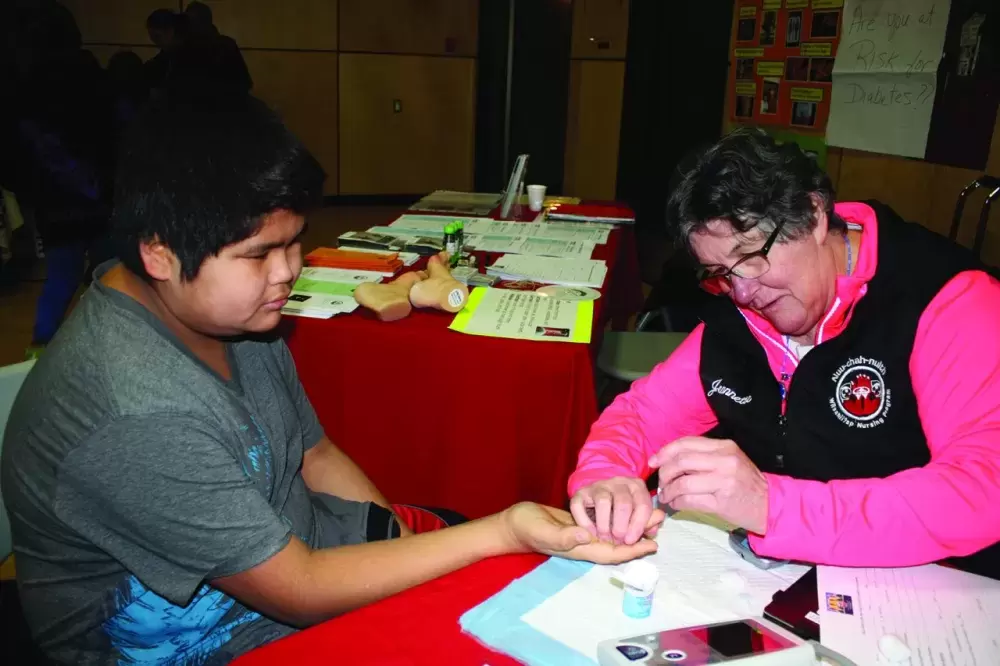If you are an aboriginal person, chances are you or someone in your family has diabetes. That’s because First Nations people are at higher risk for the disease, but a recent change in medical benefits coverage in B.C. has left some Indigenous diabetics unable to afford the medication they need.
A study in Alberta suggested that the lifetime risk of diabetes was eight in 10 for First Nations persons over the age of 18 years compared with five in 10 for non-First Nations people (Canadian Medical Association Journal 2016).
“Colonization is recognized world-wide as the most significant social determinant of health,” wrote Dr. Keith G. Dawson in a British Columbia Medical Journal article. “Other social determinants affecting diabetes in First Nations include poverty, isolation, poor access to care, food insecurity, obesity and lack of health education.”
Unhealthy eating habits compound the risks.
“Urbanization means that food is no longer obtained by traditional hunting and gathering methods but is bought from a local commissary stocked with high-carbohydrate, energy-dense prepared foods promoted by ubiquitous advertising,” Dr. Neilson continued.
According to NTC diabetes nurse Beth Neilson, diabetes is a chronic, progressive disease. It occurs when one's body has difficulty producing and using insulin, resulting in high blood sugars.
“Chronically high blood sugars can lead to long-term complications, such as kidney disease, eye disease, nerve problems resulting in ulcers and amputations, heart disease and stroke,” wrote Neilson.
Of the 10,000 registered Nuu-chah-nulth-aht, Neilson says the nursing department knows of 179 diabetics – but that is probably only the tip of the iceberg. There are many undiagnosed diabetics and prediabetics, she said.
The good news is that diabetes can be managed through changes in diet, lifestyle and medications which can reduce the risk of chronic complications. Some of the medications available to First Nations diabetics through their Pharmacare Plan W formulary are known as blood glucose-lowering therapies. Most newly-diagnosed type 2 diabetics are prescribed a medication called Metformin.
If the patient is not responding well to Metformin there are other diabetes therapies, including second-line medications that offer more stability in blood sugar levels as well as other benefits, but they are expensive. These second-line medications not only treat diabetes but provide additional benefits for people diagnosed with a cardio-vascular disease (CVD) like hypertension, heart disease, stroke and more.
First Nations people are also at higher risk of developing a CVD as well as complications from diabetes, says Neilson.
“Diabetes Canada recommends that people with diabetes who aren't meeting their blood sugar targets should be started on a second-line medication, after trying Metformin,” said Neilson.
The top recommended second-line medications are canagliflozin (Invokana), empagliflozin (Jardiance) and liraglutide (Victoza).
“These medications are safer (there is less risk of low blood sugars), help with weight loss, are more effective for lowering sugars, and also help protect people against heart attack and stroke,” said Neilson.
But these medications are not covered by Pharmacare Plan W. There are no generic forms of these medications, so it falls upon the patient to cover the $400-per-month cost of the prescription. Neilson says the price tag puts these second-line medications out of range for many diabetics. Adding insult to injury, the drugs are covered in other Canadian provinces – just not British Columbia.
Prior to the switch from NHIB (National Health Care Benefits) to the First Nations Health Authority Pharmacare, both medications were covered.
According to FNHA Media Relations spokesperson John Moody, the First Nations Health Authority made the drug benefit transition to better meet the needs of B.C. First Nations.
“While some drugs are currently not available under the new plan, all patients continue to receive effective therapies, including those with diabetes,” he wrote in an email to Ha-Shilth-Sa. He went on to say that FNHA is now working with their partners at Canada’s Ministry of Health to increase the drugs available to clients and have identified diabetic drugs as a priority.
The change of health care benefits for First Nations people in British Columbia happened in October 2017. At that time FNHA and BC Pharmacare attempted to make the switch as seamless as possible.
Those that were prescribed the diabetes medications prior to the change-over were grandfathered in and their drugs continue to be covered, but prescriptions coming after October 2017 are not eligible for Pharmacare Plan W coverage.
“Plan W severely limits or denies access to diabetes medications that were previously covered,” wrote Dr. Dawson. “This means Indigenous British Columbians do not have ready access to many guideline-recommended therapies that can mitigate the negative impact of diabetes.”
Those that have been denied coverage for diabetic medication not covered by Plan W are being advised to file an appeal with FNHA.
“All appeals that I've heard of have been denied by FNHA,” said Neilson.
FNHA has been working to address the diabetes epidemic by launching the mobile diabetes telemedicine clinic program. In addition, diabetes screening is available at the Nuu-chah-nulth Tribal Council.
But Neilson is concerned that the diabetes medication is not being covered due to costly price tag; and if that is the case the cost-saving measures would be short-sighted.
“The health care costs will increase in the long term when diabetics develop retinopathy, kidney problems, face amputations and tons of other complications if diabetes isn't managed,” she said. “Diabetes is a chronic and progressive disease and it's not the patient's fault that they need medication.”







